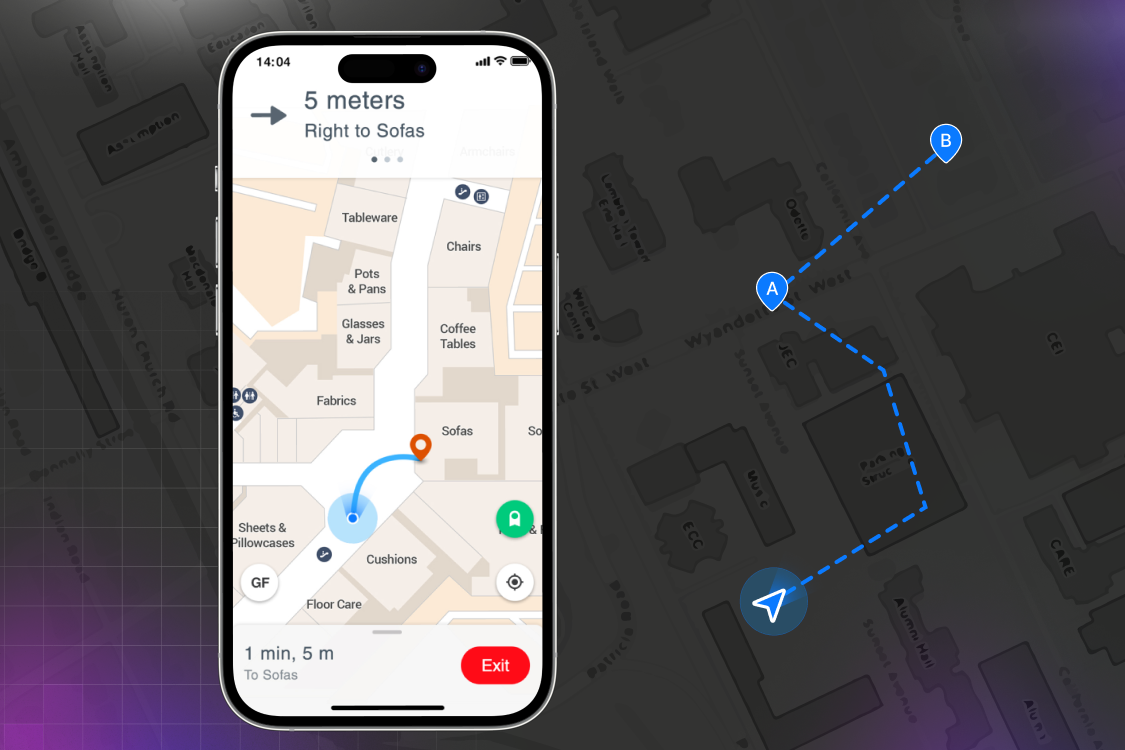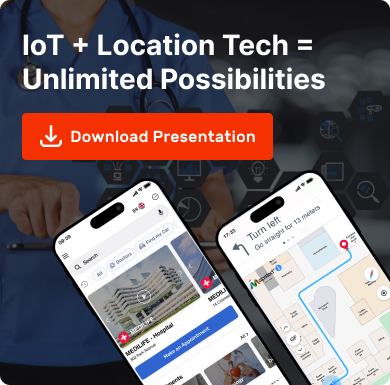IoT Solutions

Indoor location tracking has come a long way—from the humble beginnings of RFID tags to today’s cutting-edge IoT-powered solutions. As we enter the later half of 2024, the future of IoT promises to be nothing short of revolutionary. Imagine a world where businesses achieve unprecedented precision in tracking and efficiency, all thanks to the transformative power of IoT.
Ready to explore how IoT is used in location tracking and how it is reshaping the landscape of location technology? Let’s uncover the innovations driving this leap forward and what lies ahead in this rapidly evolving industry.
How Do Industries Use IoT for Indoor Location Tracking?
The Internet of Things (IoT) interconnects a multitude of devices in such a way that they are able to communicate with each other. Like many other applications, IoT for location tracking uses a variety of sensors, tags and communication technologies to determine the positions of objects, assets and people.


1. Healthcare
In healthcare applications, IoT-based indoor location tracking technology improves patient care and system functionality. Hospitals employ IoT solutions from solution providers such as Mapsted, whose Tag technology accurately tracks the location of essential medical equipment, ensuring timely availability. Additionally, IoT location tracking devices such as Mapsted Badge can track staff and patient locations within healthcare facilities, improving emergency response times, security and the patient experience.
2. Retail
Retailers use IoT indoor location tracking tech to optimize shopper satisfaction and streamline business processes. Indoor location technology helps navigate customers to products in stores and send targeted promotions. This not only enhances customer satisfaction but also boosts sales through targeted advertising, reflecting the future of IoT in 2024.
3.Manufacturing
Within manufacturing environment, location tracking IoT devices can accurately identify the location of valuable equipment, personnel, raw materials and finished products in factories. With real-time updates, it is easy to improve production lines, reduce downtimes and streamline inventory management, making indoor location tracking a crucial part of operational efficiency.
4. Logistics
Indoor location technology is invaluable in logistics. Warehouses use IoT for indoor asset tracking, improving product location accuracy, inventory control and overall supply chain management. The future of IoT will see further advancements in this sector, leading to more efficient and timely dispatches and deliveries.
5. Hospitality
In the hospitality industry, indoor location tech powered by IoT technology enhances guest services and reduces operational costs. Hotels and resorts use indoor location tracking tech to optimize staffing levels, guide guests to their rooms, and points of interest, and monitor staff for efficient room service and housekeeping. Streamlining these processes create superior guest experiences and ensure prompt and effective service delivery.
6. Education
Educational institutions utilize IoT to track campus assets and staff, improving safety and resource management. Schools and universities monitor student and staff locations using indoor location technology, ensuring safety and optimizing the usage of valuable equipment. With improved visibility into asset locations, campuses can streamline operations, enhance accountability and create a more effective learning environment for faculty and students.
Location Tracking in IoT Devices
IoT devices support indoor location tracking, offering valuable applications within indoor location.
1. Asset Tracking
IoT devices for asset tracking play a vital role in determining the location and status of valuable assets in indoor environments. By delivering real-time updates, these devices showcase how IoT enhances location tracking for more efficient asset management.
2. Inventory Management
Indoor location technology is crucial in inventory management within retail and manufacturing. By tracking the location of merchandise in real-time, IoT enhances stock management and reduces stockouts.
3. Locating People
Wearable IoT devices such as Mapsted’s discreet Badge technology, are used to monitor personnel indoors. In large facilities such as hospitals, corporate offices, universities, shopping malls and factories, these devices are essential for monitoring staff locations, improving safety, customer service and operational efficiency.
4. Security and Surveillance
IoT-enabled indoor location technology enhances security and surveillance systems. Smart cameras with location detection can monitor specific areas and trigger alerts when movement is detected in restricted zones, demonstrating the impact of location tracking in IoT devices on security.
Challenges and Opportunities
While the advancements in indoor location tracking are promising, there are challenges to overcome, including high deployment costs and privacy concerns. However, the future of IoT offers immense opportunities for businesses to leverage these technologies for growth and competitive advantage.
Impact on Business Operations
IoT indoor location tracking is poised to revolutionize business operations. From healthcare to retail, indoor location tracking services will improve efficiency, enhance customer experiences and drive business growth, marking the future of IoT in 2024 as a pivotal moment for innovation.
Conclusion
By early 2030, how IoT is used in location tracking will have changed business operations across various industries. The future of IoT is set to revolutionize indoor location tracking, offering businesses new opportunities to enhance productivity, customer satisfaction and security in an increasingly interconnected world. If you liked learning more about IoT location tracking, you may also enjoy our blog on the Location Tracking Market – $24B by 2027: What To Expect? and our quick video: Explore Mapsted’s Location Based Technology Solutions for Forward-Thinking Businesses.
Frequently Asked Questions
Q1. How is IoT used in indoor location tracking?
Ans. IoT employs sensor-equipped devices to capture the real-time location of objects indoors, enhancing operations across various industries.
Q2. What is the future of indoor IoT in 2024?
Ans. The progression for indoor IoT in 2024 includes advancements in AI, 5G and edge computing, leading to more efficient and reliable indoor positioning systems.
Q3. What technologies are used in indoor location tracking?
Ans. Indoor location tracking utilizes a variety of technologies to accurately determine the position of objects and people in enclosed spaces. By combining these technologies, organizations can enhance operational efficiency and asset management in various indoor environments. technology to provide accurate location details inside buildings.
Q4. How do IoT devices enhance asset tracking in indoor environments?
Ans. IoT devices for asset tracking combine several technologies to provide real-time updates on the location and status of valuable assets, ensuring quick access and efficient management.
Q5. What are the benefits of using IoT in indoor security and surveillance?
Ans. Security and surveillance systems through IoT can monitor specific regions, detect intruders and alert owners of potential threats in offices, stores or public areas.
